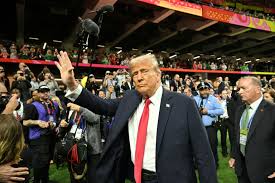Former U.S. President Donald Trump’s attendance at the recent Super Bowl sparked significant discussions, but did it truly enhance the event’s visibility and popularity? While Trump’s presence generated media attention, the Super Bowl has long been a global spectacle, making it difficult to attribute any significant boost in popularity to his attendance alone.
The Super Bowl is one of the most-watched sporting events worldwide, attracting millions of viewers each year. It is not just about football; it is a cultural phenomenon featuring top-tier entertainment, high-profile advertisements, and a massive global audience. Given its status, the event does not necessarily require a political figure to gain attention.
This year’s Super Bowl, held in New Orleans, was no exception. The Philadelphia Eagles secured a dominant 40-22 victory over defending champions, the Kansas City Chiefs. The event featured electrifying performances from top musicians and was attended by Hollywood A-listers, sports icons, and music stars. Celebrities such as Jay-Z, Beyoncé, Ice Spice, Kendrick Lamar, Lionel Messi, Taylor Swift, Bradley Cooper, Paul Rudd, Russell Wilson, and Ciara were among those present.
Read Also: Trump to become 1st incumbent president to attend Super Bowl
Donald Trump’s appearance at the event undoubtedly drew media coverage, particularly among his supporters and political critics. However, did it significantly alter viewership numbers or global interest in the Super Bowl? At the time of writing, no official data suggests that his attendance led to a noticeable spike in viewership or engagement.
Historically, Trump has had a complicated relationship with the NFL. His past criticism of the league’s handling of player protests and his involvement in the failed USFL (United States Football League) have often placed him at odds with the NFL establishment. His presence at the Super Bowl may have been notable, but it was not necessarily a game-changing moment for the event’s popularity.
The Super Bowl’s significance extends far beyond the game itself. Its halftime show is one of the most coveted performance slots in the music industry, with past performances from icons like Michael Jackson, Beyoncé, and Rihanna. Additionally, Super Bowl commercials are the most expensive advertising slots on television, with companies spending millions to air their most creative and high-budget ads.
Economically, the event also drives massive consumer spending. Super Bowl Sunday is the second-largest food consumption day in the U.S., only behind Thanksgiving. Fans spend an average of $58 per game on food and drinks, making it a commercial juggernaut regardless of political figures in attendance.
While Trump’s attendance at the Super Bowl was noteworthy, the idea that he significantly boosted the event’s popularity is debatable. The Super Bowl is already a global event with a well-established audience. Political figures, celebrities, and high-profile athletes regularly attend, but their presence does not necessarily change the event’s standing or appeal.
If viewership data eventually shows a major increase linked to Trump’s presence, it would be worth analyzing further. However, for now, the Super Bowl remains an American spectacle driven by its own cultural significance, with or without the presence of Mr. President.






